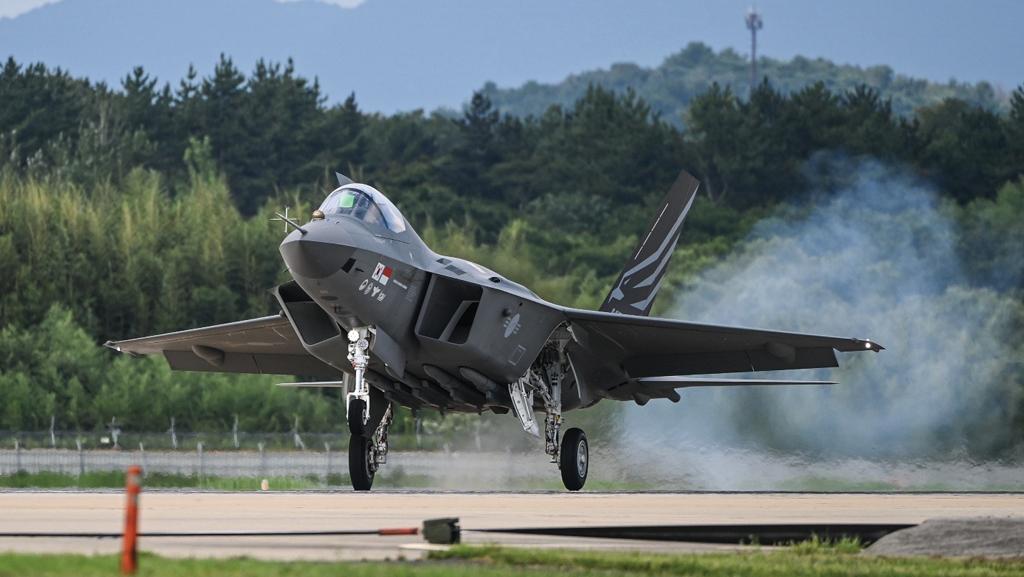
KF-21
ANAHEIM, California—The Korea Aerospace Industries (KAI) KF-21 Boramae multirole fighter is performing well in initial flight tests and matching handling qualities predicted by modeling simulations, the Republic of Korea Air Force (ROKAF) evaluation team says.
The twin-engine fighter made its first flight from Sacheon, South Korea, on July 19 and is scheduled to attain initial air-to-air operational capability in 2026. Slightly smaller and lighter than the Boeing F/A-18E/F, the KF-21 uses a version of the same General Electric F414-400 engine, which gives the aircraft a thrust-to-weight ratio comparable to the Eurofighter Typhoon.
Targeting high maneuverability throughout the subsonic and transonic speed ranges, the KF-21 has a lower wing loading than the Lockheed Martin F-35 at equivalent thrust. The behavior of the flight control system and associated stability and control augmentation system therefore forms a key focus for the initial part of the Block 1 test and evaluation (T&E) program.
Divided into two main phases running through early 2026, the first KF-21 T&E phase has been divided into two tracks during which operational and development testing and evaluation (OT&E/DT&E) will be conducted virtually in parallel. The first DT&E phase began in March 2021–more than a year before first flight—and is scheduled to wrap up in August 2023. The OT&E effort, which began in June 2021, is due to be completed at the same time after running for 27 months.
Pending successful tests and an operational assessment that summer, the program will enter a what ROKAF describes as a “full-up” flight test phase. Running through early 2026, the intensive follow-up T&E flight test effort will again comprise parallel OT&E and DT&E phases—both of which are due to end in February of that year after a 30-month period.
Commenting on the early success of the test campaign at the Society of Experimental Test Pilots’ annual symposium here, members of the ROKAF’s 52nd Test and Evaluation Group estimate that the entire Block 1 program will involve more than 2,000 test flights, of which roughly 1,700 will occur during the follow-up T&E phase. This is scheduled to conclude with a second operational assessment in early 2026.
The KF-21’s triplex digital flight control system is designed around a nonlinear dynamic inversion (NDI) control law architecture. Like the system developed for the F-35, the NDI control combination is designed to provide a predictable response to a commanded trajectory, and control loops shape the response as desired.
In the run-up to flight tests, control system and components have been—and continue to be—evaluated and verified using a combination of an “iron bird” ground test rig and a maneuverability analysis simulator or handling quality system (HQS). Gradually assembled from early 2016 onward, the ground rig and HQS developed a model against which the initial flight test results could be assessed, says Lt. Col. Seong Bin Park, commander of the 52nd Test and Evaluation Group’s 281 Flight Test Sqn.
“The critical point was the HQS and how it reacted on the first flight,” says Park, who adds it was “our biggest concern.” However, initial handling qualities after takeoff were found to be so close to the HQS predictions that “we talked to the test pilot and decided to cancel a planned practice landing at 5,000 ft. When we ended the first flight, the happiest were the HQS engineers because the results were very similar to what they expected.”
Responding to questions about why the first flight was conducted with four MBDA Meteor air-to-air missiles mounted semi-recessed into the lower fuselage, Park says “our first plan was to test in clean configuration, but because of budget and the timeline, saving time was critical for the ROKAF.” He adds that the low-drag missile installation was “actually comparable to a clean configuration, so we decided to go into the most basic way of doing the first flight. Results and timeline mattered, so we decided to go with the missiles.”
Initial Block I flight tests will continue to focus on envelope expansion as well as the baseline flight control modes. These include the air-to-air “up and away” mode; power approach mode for landing and an air-refueling mode. The control laws also incorporate envelope protection with low-speed warning and angle-of-attack limiter functions. The KF-21 flight control system also includes a reconfigurable control function to enable continued stable flight in the event of the failure of control surface actuators, an engine or air data sensors.
Block I also will include tests of a pilot-activated recovery system as a prelude to test and development of an automatic ground collision avoidance system during Block II. “For this phase the objective is to conduct full air-to-air and air-to-ground combat operational capabilities,” says Maj. Younjae Choi of the 281 Flight Test Sqn. Planning for Block II, which will also include tests of an automatic terrain following system, is now complete, he adds.
The overall test campaign will involve eight prototype KF-21s, including two airframes for static and fatigue ground tests. Of the six flying aircraft, four are single-seaters and two are two-seaters. In addition, KAI plans to produce an initial batch of 40 Block I production aircraft that will be targeted at air-to-air missions and some limited air-to-ground missions. For Block II, the company is gearing up to produce 80 aircraft with full air-to-ground capability that will be delivered from 2028.
Beyond this, ROKAF is studying a potential upgraded Block III variant, while KAI has recently outlined a possible carrier-capable KF-21N variant.
